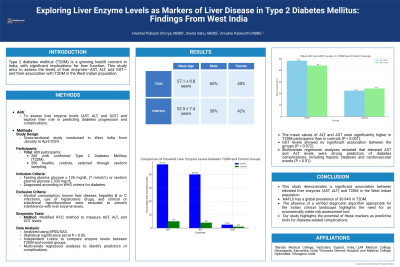Sunday Poster Session
Category: Liver
P1164 - Exploring Liver Enzyme Levels as Markers of Liver Disease in Type 2 Diabetes Mellitus: Findings From West India
Sunday, October 27, 2024
3:30 PM - 7:00 PM ET
Location: Exhibit Hall E

Has Audio

Amukta Palakurthi
Osmania General Hospital and Medical College
Visakhapatnam, Andhra Pradesh, India
Presenting Author(s)
Harshal Prakash Chorya, MBBS1, Sweta Sahu, MBBS2, Amukta Palakurthi, 3
1Baroda Medical College, Vadodara, Gujarat, India; 2JJM Medical College, Devanagere, Karnataka, India; 3Osmania General Hospital and Medical College, Visakhapatnam, Andhra Pradesh, India
Introduction: Type 2 diabetes mellitus (T2DM) is a growing health concern in India, with significant implications for liver function. This study aims to assess the levels of liver enzymes—AST, ALT, and GGT—and their association with T2DM in the West Indian population and the potential role of these markers in predicting the progression and complications of diabetes.
Methods: A cross-sectional study was conducted in West India from January to April 2024. The study included 400 participants, with 200 confirmed T2DM cases and 200 healthy controls, selected through random sampling. Enzymatic tests were done using the modified IFCC method to determine AST, ALT, and GGT levels. Data were analyzed using SPSS/SAS, with statistical significance set at P < 0.05. An independent t-test compared enzyme levels between T2DM and control groups. Additionally, multivariate regression analyses were also conducted.
Results: The mean age of T2DM participants was 57.1 ± 9.8 years, and controls were 52.5 ± 7.4 years. Men constituted 60% of the T2DM group and 58% of the control group. Among T2DM participants, 95 (47.5%) had elevated AST levels, 80 (40%) had elevated ALT levels, and 5 (2.5%) had elevated GGT levels. In the control group, 10 (5%) had elevated AST, 8 (4%) had elevated ALT, and 2 (1%) had elevated GGT.
The mean values of ALT and AST were significantly higher in T2DM participants than in controls (P < 0.001). Specifically, the mean ALT in T2DM participants was 48.2 ± 21.6 IU/L compared to 22.4 ± 7.5 IU/L in controls. The mean AST was 44.1 ± 20.3 IU/L in T2DM participants and 24.3 ± 8.1 IU/L in controls. GGT levels showed no significant association between groups (P = 0.072). Multivariate regression analyses revealed that elevated AST and ALT levels were strong predictors of diabetes complications, including hepatic steatosis and cardiovascular events (P < 0.01).
Discussion: This study demonstrates a significant association between elevated liver marker enzymes (AST and ALT) and T2DM in the West India population. NAFLD has a global prevalence of 30-94% in T2DM. The absence of a verified diagnostic algorithm appropriate for the Indian clinical landscape highlights the need for an economically viable risk assessment tool. Our study highlights the potential of these markers as predictive tools for diabetes-related complications.
Disclosures:
Harshal Prakash Chorya, MBBS1, Sweta Sahu, MBBS2, Amukta Palakurthi, 3. P1164 - Exploring Liver Enzyme Levels as Markers of Liver Disease in Type 2 Diabetes Mellitus: Findings From West India, ACG 2024 Annual Scientific Meeting Abstracts. Philadelphia, PA: American College of Gastroenterology.
1Baroda Medical College, Vadodara, Gujarat, India; 2JJM Medical College, Devanagere, Karnataka, India; 3Osmania General Hospital and Medical College, Visakhapatnam, Andhra Pradesh, India
Introduction: Type 2 diabetes mellitus (T2DM) is a growing health concern in India, with significant implications for liver function. This study aims to assess the levels of liver enzymes—AST, ALT, and GGT—and their association with T2DM in the West Indian population and the potential role of these markers in predicting the progression and complications of diabetes.
Methods: A cross-sectional study was conducted in West India from January to April 2024. The study included 400 participants, with 200 confirmed T2DM cases and 200 healthy controls, selected through random sampling. Enzymatic tests were done using the modified IFCC method to determine AST, ALT, and GGT levels. Data were analyzed using SPSS/SAS, with statistical significance set at P < 0.05. An independent t-test compared enzyme levels between T2DM and control groups. Additionally, multivariate regression analyses were also conducted.
Results: The mean age of T2DM participants was 57.1 ± 9.8 years, and controls were 52.5 ± 7.4 years. Men constituted 60% of the T2DM group and 58% of the control group. Among T2DM participants, 95 (47.5%) had elevated AST levels, 80 (40%) had elevated ALT levels, and 5 (2.5%) had elevated GGT levels. In the control group, 10 (5%) had elevated AST, 8 (4%) had elevated ALT, and 2 (1%) had elevated GGT.
The mean values of ALT and AST were significantly higher in T2DM participants than in controls (P < 0.001). Specifically, the mean ALT in T2DM participants was 48.2 ± 21.6 IU/L compared to 22.4 ± 7.5 IU/L in controls. The mean AST was 44.1 ± 20.3 IU/L in T2DM participants and 24.3 ± 8.1 IU/L in controls. GGT levels showed no significant association between groups (P = 0.072). Multivariate regression analyses revealed that elevated AST and ALT levels were strong predictors of diabetes complications, including hepatic steatosis and cardiovascular events (P < 0.01).
Discussion: This study demonstrates a significant association between elevated liver marker enzymes (AST and ALT) and T2DM in the West India population. NAFLD has a global prevalence of 30-94% in T2DM. The absence of a verified diagnostic algorithm appropriate for the Indian clinical landscape highlights the need for an economically viable risk assessment tool. Our study highlights the potential of these markers as predictive tools for diabetes-related complications.
Disclosures:
Harshal Prakash Chorya indicated no relevant financial relationships.
Sweta Sahu indicated no relevant financial relationships.
Amukta Palakurthi indicated no relevant financial relationships.
Harshal Prakash Chorya, MBBS1, Sweta Sahu, MBBS2, Amukta Palakurthi, 3. P1164 - Exploring Liver Enzyme Levels as Markers of Liver Disease in Type 2 Diabetes Mellitus: Findings From West India, ACG 2024 Annual Scientific Meeting Abstracts. Philadelphia, PA: American College of Gastroenterology.
